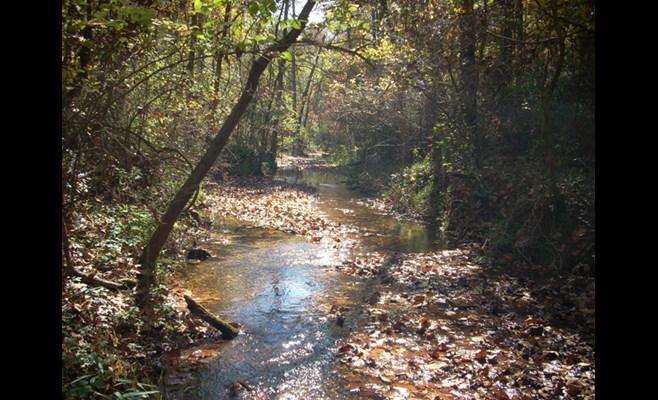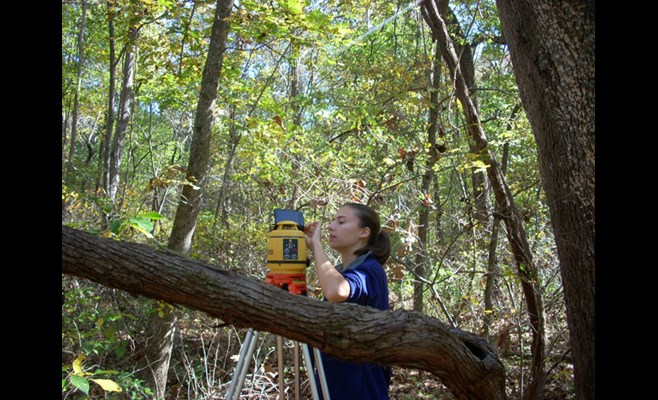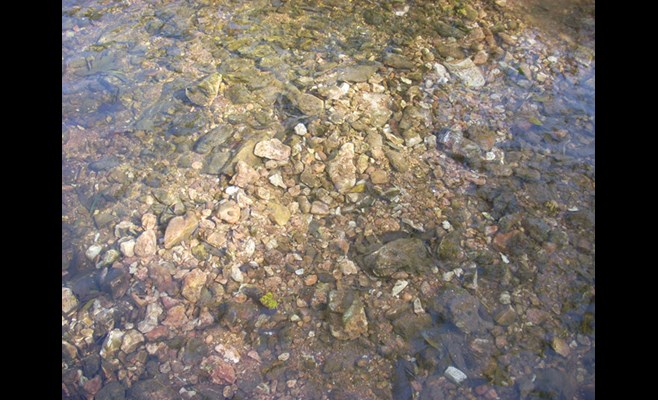Study Findings Have Impact Up and Down Stream
FAYETTEVILLE, Ark. – A University of Arkansas researcher and her colleagues examined streams in urban, agricultural and forested settings and determined that the differences they found may affect how cities try to restore urban streams.
Geosciences researcher Stephanie Shepherd, geosciences professors John C. Dixon and Ralph K. Davis, and graduate student Rose Feinstein report their findings in River Research and Applications.
Shepherd’s work examined the shape of headwater streams, as well as the materials found in them, in cities, on farmland and in forested areas in the Illinois River watershed in northwest Arkansas. She found that the material in streams shifted from gravel in the forested streams to a high percentage of bedrock in the urban streams. Scientists know that urban streams run deeper and faster than forested streams, but until now the reasons haven’t been completely clear.
“The research shows one way that change is occurring in these streams,” Shepherd said. “It also suggests that just making an urban stream look like a forested stream will probably fail.”
To arrive at this conclusion, Shepherd looked at floodplains, measured depths and counted pebbles in streams at several sites in each land use category as determined by land use surveys – urban, agricultural and forest. Forested sites had more sinuous streams than the agricultural or urban sites. The forested streams had meander bends with gravel bars, which were absent in the urban and agricultural streams. Urban streams also ran significantly wider and deeper than those found on farmland and in forests.
The biggest difference between streams occurred in the materials found in the different settings. Urban streams had a lot of exposed bedrock, while agricultural streams had less than 1 percent exposed bedrock and forested streams had no exposed bedrock.
The exposed bedrock in urban streams occurs when cities harden the banks of a stream, create drainage channels or pave and reinforce the landscape surrounding it. This decreases new input into the urban stream. It also forces water into the stream that, in a forested setting, would be absorbed into the ground. This forced water produces high-speed flow, which then moves material such as stones and pebbles through quickly, sometimes scouring the bottom of the stream all the way to the bedrock.
“Streams are not static – materials are moving through them at different velocities all the time,” Shepherd said. “If there are not new gravel inputs in urban streams, we have to think of them as a different system.” Many of the physical characteristics surrounding forested streams, such as large areas of undisturbed soil, cannot be reproduced in an urban setting, she said, so scientists should explore new ways besides simple restoration to mitigate urban streams.
Shepherd and her colleagues work in the department of geosciences in the J. William Fulbright College of Arts and Sciences at the University of Arkansas.
Topics
Contacts
Stephenie Shephard, researcher, geosciences
J. William Fulbright College of Arts and Sciences
479-575-3355,
slsheph@uark.edu
Melissa Blouin, director of science and research communication
University Relations
479-575-3033,
blouin@uark.edu
Headlines
Four Students Named Goldwater Scholars; Two Earn Udall Honorable Mentions
Four U of A students have received the prestigious Goldwater Scholarship, an award for top students in mathematics, science, and engineering.
Cross-Campus Collaboration Culminates in New Outdoor Geological Installation
Grand opening event to celebrate the new GeoLab installation at the U of A’s Gearhart Hall courtyard is set for May 3. The installation will be open to the public year-round.
First Students to Use Online Degree to Hone Nursing Leadership, Elevate Patient Care
Hanna Baxendale and Wendi Kimbrell will begin coursework in the Doctor of Nursing Practice-Executive Master of Business Administration program offered by the Eleanor Mann School of Nursing and Walton College.
Join the Office for Sustainability on a Final Cruise to Campus
Cruise to Campus Wednesdays have fostered a gathering space for individuals interested in biking to campus. Drop by the Old Main Lawn from 7:30-10 a.m. Wednesday for coffee, something to eat and conversation.
Fay Jones School Student Ambassador Program Gives Voice to Design Students
The student ambassador program at the Fay Jones School of Architecture and Design is built to connect top design students with their school, its alumni, its future students and others inside and outside the school.







